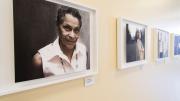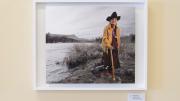Three years ago, photographer and social documentarian Matika Wilbur set out on an ambitious journey to photograph members of every Native American tribe in the United States, with the hope of shedding light on the lives and experiences of Native communities across the country. The result is her new exhibition at the Radcliffe Institute for Advanced Study: “Seeds of Culture: The Portraits and Stories of Native American Women”—a series of striking photographs of, writings about, and audio interviews with Native American women, depicting how ancestral and contemporary identities have shaped their lives.
“In time, I’ve realized the best way to see is to listen,” Wilbur said during a preview of the exhibition last week. “Native women are traditionally the stewards of the vital relationship with land, and have remained principal advocates for Mother Earth, from fracking protests to enduring matrilineal values. I believe the viewers will experience great understanding and connection with these remarkable women, just as they have enlightened and inspired me.” (Radcliffe is hosting the exhibition in partnership with the Harvard University Native American Program as part of an initiative on Native and Indigenous Peoples—a series of lectures, conferences, exhibitions, seminars, and archival research.)
Wilbur, a Native American woman of the Swinomish and Tulalip Tribes of the Pacific Northwest and the creator of Project 562—a series of images and oral narratives of each of the then 562 (now 566) federally recognized tribes in the United States—said her work is inspired by an identity struggle she has dealt with since her childhood, when she lived in a predominately white, middle-class town. Her photographs, she pointed out, offer a new perspective on Native Americans that she feels is often missing from traditional history lessons. Despite the cultural, economic, and political progress of Native Americans in recent years, she explained, misleading and stereotypical images remain, such as Indians in feathered headdresses holding bows and arrows.
Yukio Lippit, professor of history of art and architecture, introduced Wilbur to a packed audience at Radcliffe at the exhibit opening. He called her work not only visually compelling, but also important for the way it sheds light on the experiences of Native Americans, and represents a “new, dynamic way” of being an artist by making use of her travels and interviews.
In her talk at the opening, Wilbur said the stories she has heard from Native women all over the country have “laid heavily” on her heart. Grandmothers have told her how they went to clinics to have their first baby, only to be sterilized afterward without their consent—victims of a “de facto government one-child policy.” Married women have discussed their abusive husbands, detailing scenes of violence, loneliness, and despair. One woman recalled how she was raped while serving in the army, and then demoted when she sought justice. Other women revealed their fears of tribal suicide among children. Single mothers detailed their struggles to pay rent. “When I sit down with women, they erupt with their innermost stories,” she said. “Women tell me how difficult it is to choose a mate when racist policies determine their future children’s opportunity for tribal citizenship. Women speak with me about the difficulty of fitting into academic environments when the faces, books, and spaces around them do not include them. It’s a lot.”
Native American women are among the most victimized women in the country, Wilbur pointed out. Three out of four have experienced sexual assault or domestic abuse in their lifetimes. The United States, she said, is at a critical time in what she calls an “epidemic of abuse” toward Native women. Her work, she added, strives to convey their collective voice and struggle.
“Native women are here to tell you their own stories,” Wilbur said. “Native women’s suffering and loss are part of the indigenous reality that exists, and it must be respected—it must be of concern to us all. I have found in our women’s stories a treasure trove of knowledge, strength, and vision.”
Seeds of Culture: The Portraits and Stories of Native American Women is on display in the Johnson-Kulukundis Family Gallery at the Radcliffe Institute for Advanced Study until May 28, and is free and open to the public.
Watch a video of Wilbur discussing her journey with Project 562: youtube.com/watch?v=7JrRBQEQr3o









